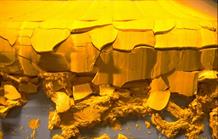The challenges around front-end
of the fuel cycle
The operation of nuclear reactors requires uranium of high purity, which is a significant challenge for chemistry because the uranium must be purified of all the other elements present in the ore. Romain Grastien, head of the CEA Nuclear Energy Division programme on the “front-end of the fuel cycle”, sums up the situation this way: “Uranium accounts for no more than a few weight percent of the ore. In addition, natural uranium contains only 0.7% fissile
235U (the remainder being
238U), whereas pressurised water reactor fuel must contain 4%
235U.” In the 1950s and 1960s, CEA-DEN designed and implemented the entire industrial chain from crude ore1 to enriched uranium.
Today nearly 55,000 tonnes of uranium are mined annually compared with a consumption of 65,000 tonnes2. “Eventually, with the depletion of existing mines, we will have to learn to exploit poorer deposits at reasonable cost under the best environmental conditions” cautions Romain Grastien. R&D on the entire front-end of the fuel cycle has adapted to the situation.
Uranium extraction and purification
Everything begins at the mine where uranium is extracted. The ore is crushed, ground, and then impregnated with an oxidising acid solution to dissolve the uranium to a few grams per litre. Uranium is then selectively extracted from solution by a specific molecule that has been used since the 1970s. This is followed by several purification steps to obtain a uranium concentrate called yellowcake. “We want to eliminate the final steps, which consume large amounts of water and reagents, by developing a new extractant molecule to obtain a sufficiently purified solution after the first operation” explains Romain Grastien. Over the longer term, the chemists seek to further diminish water consumption by rethinking the extraction phase itself.

Yellow cake: uranium concentrate obtained after dissolution of uranium ore in acid © Philippe Lesage/Areva
1 The CEA was initially responsible for mining exploration before this activity was transferred to Cogema in 1976.
2 2014 data, WNA source.
3 An increasingly used method — especially at Kazakhstan — also known as in situ recovery.It represents 50% of the uranium that is mined.
4 Extraction occurs when the solution from the well is filtered on an ion exchange resin.
Another mode of operation is also used:
in situ leaching3. With favorable geology, excavation is unnecessary: uranium is recovered directly by injecting an oxidising acid solution into the deposit and then pumping the solution. Here again, the researchers seek to eliminate the purification steps by improving the method of extraction.
From yellowcake to enriched uranium
At the Comurhex Malvési conversion plant, yellowcake undergoes further purification before being converted to uranium tetrafluoride, which is then converted at the Comurhex Pierrelatte plant to uranium hexafluoride by fluorination. As this is a very expensive product, CEA experts are working on recycling it. Then comes enrichment. During this operation, gaseous uranium is injected into the centrifuges where it is separated into two flows: one enriched in 235U (between 3 and 5%) and the other depleted in 235U (0.1 to 0.3%). The first enrichment plant, named after Georges Besse, used gaseous diffusion — the only mature technology at the time it was commissioned (1978). Today, the Georges Besse II plant uses gas ultracentrifuge technology, which consumes 40 to 50 times less energy. The enriched hexafluoride is once again converted to solid uranium oxide for fuel fabrication. Chemists are now attempting to recover the valuable fluoride during this operation for reuse it during the preceding enrichment step — while keeping an eye on emerging processes, such as laser-based systems, that could supplant ultracentrifugation.